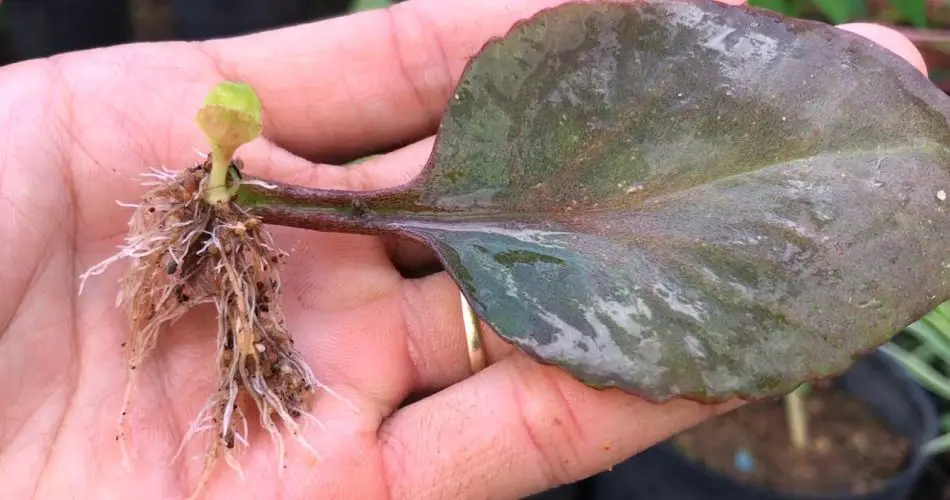If you’re looking for an easy and rewarding way to propagate a beautiful and resilient plant, Bryophyllum pinnatum (also known as Kalanchoe pinnata or Bryophyllum calycinum) is an excellent choice. This succulent plant, which is native to Madagascar, is known for its vibrant green leaves and its ability to propagate through leaf cuttings. In this guide, we’ll show you how to grow Bryophyllum pinnatum from leaves, giving you a step-by-step process to help you grow this hardy, low-maintenance plant right from home.

Why Grow Bryophyllum Pinnatum from Leaves?
Before diving into the propagation process, let’s discuss why Bryophyllum pinnatum (also known as Kalanchoe pinnata) is so special:
- Easy to Propagate: Unlike many plants, Kalanchoe pinnata can propagate not just from cuttings but also from the leaves. The leaves contain specialized structures that allow them to form new plants, making this an easy and efficient method.
- Low Maintenance: This succulent plant is perfect for beginner gardeners, as it requires minimal care and attention. It can thrive in a variety of conditions, including poor soil and low water levels.
- Medicinal Uses: Beyond its aesthetic appeal, Bryophyllum pinnatum has been traditionally used for its medicinal properties, such as treating wounds, inflammation, and various ailments, making it a great addition to your garden or home.
Now, let’s go over the process of growing Bryophyllum pinnatum from leaves.
Materials You Will Need:
- Healthy Bryophyllum pinnatum leaves (preferably from a mature plant)
- A shallow container (such as a small tray or pot)
- Well-draining soil (cactus or succulent mix works best)
- A spray bottle for light misting
- A sunny location with indirect light
Step-by-Step Guide to Grow Bryophyllum Pinnatum from Leaves
Step 1: Choose Healthy Leaves
The first step in propagating Bryophyllum pinnatum from leaves is to select healthy, mature leaves from the parent plant. You’ll want leaves that are undamaged, free from diseases, and preferably large, as they will have more energy to produce new plants.
- Gently pluck the leaves from the plant, or use a clean, sharp knife to cut them at the base of the leaf.
Step 2: Let the Leaves Callus
Once you’ve removed the leaves from the plant, it’s important to let the cut edges callus over. This prevents the leaves from rotting once they are placed in soil.
- Place the leaves on a clean, dry surface (like a paper towel) and let them sit for 1-2 days to allow the edges to dry and form a protective layer.
Step 3: Prepare the Soil
Next, you’ll need to prepare the soil for your leaves. Bryophyllum pinnatum prefers well-draining soil, so a cactus or succulent mix is ideal.
- Fill a shallow container or tray with the soil, ensuring it’s loose and not compacted. If you don’t have succulent soil, you can make your own mix by combining regular potting soil with sand or perlite to improve drainage.
Step 4: Plant the Leaves
Once the leaves are callused, it’s time to plant them in the soil.
- Simply place each leaf flat on top of the soil. You don’t need to bury the leaves; they should rest on the surface of the soil.
- Press down gently to ensure good contact between the leaf and the soil.
Step 5: Water Lightly
Although Bryophyllum pinnatum is a drought-tolerant plant, it will need some moisture to start rooting.
- Lightly mist the leaves with a spray bottle to moisten the soil. Be careful not to overwater, as too much moisture can cause the leaves to rot.
- Keep the soil slightly damp but not soggy.
Step 6: Provide Indirect Light
Place the container in a bright location where it can receive indirect sunlight. While Kalanchoe pinnata enjoys the sun, direct sunlight can scorch the young leaves. A windowsill with filtered light or a lightly shaded area works best.
- Keep the temperature moderate and avoid placing the leaves in a spot with harsh sunlight or extreme temperatures.
Step 7: Wait for New Roots and Shoots
Over time, you’ll begin to notice small roots forming from the base of the leaves. These roots will eventually start growing into small pups or new plantlets, which will grow into new Bryophyllum pinnatum plants.
- The process can take anywhere from 2-4 weeks, depending on the environment and care.
Step 8: Transplant New Plants
Once the new plants have developed a good root system and have grown large enough, you can transplant them into individual pots. Make sure to use well-draining soil to ensure the plant continues to thrive.
- If you’re planting multiple new plants, ensure they have enough space to grow and spread their roots.
Care Tips for Growing Bryophyllum Pinnatum
- Watering: This plant is a succulent, meaning it doesn’t require much water. Allow the soil to dry out completely between waterings. Overwatering can lead to root rot, so err on the side of underwatering.
- Light: Bryophyllum pinnatum prefers bright, indirect light but can tolerate partial shade. Avoid placing it in direct sunlight for long periods, as it can scorch the leaves.
- Temperature: Kalanchoe pinnata grows well in temperatures between 60-85°F (15-29°C). Protect it from frost or extreme cold.
- Fertilizing: You don’t need to fertilize your plant often, but if you want to encourage faster growth, you can use a diluted, balanced liquid fertilizer once a month during the growing season.
Conclusion
Growing Bryophyllum pinnatum (Kalanchoe pinnata) from leaves is a simple and effective way to propagate this stunning plant. With minimal effort and patience, you can easily create multiple new plants from just a few leaves. Whether you’re new to gardening or an experienced plant parent, Kalanchoe pinnata is an excellent addition to your collection, offering both beauty and ease of care.
By following these easy steps, you can successfully propagate Bryophyllum pinnatum and enjoy its beautiful leaves and vibrant blooms all year round! 🌿🌸



